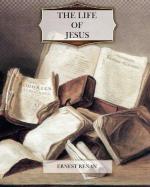[Footnote 1: Matt. viii. 11, 12, xx. 1, and following, xxi. 28, and following, 33, and following, 43, xxii. 1, and following; Mark xii. 1, and following; Luke xx. 9, and following.]
[Footnote 2: Matt. xxi. 37, and following; John x. 36, and following.]
[Footnote 3: John ix. 39.]
[Footnote 4: The most authentic form of this sentence appears to be in Mark xiv. 58, xv. 29. Cf. John ii. 19; Matt. xxvi. 61, xxvii. 40.]
[Footnote 5: John viii. 39, x. 31, xi. 8.]
[Footnote 6: Deuter. xiii. 1, and following. Comp. Luke xx. 6; John x. 33; 2 Cor. xi. 25.]
[Footnote 7: John x. 20.]
[Footnote 8: John v. 18, vii. 1, 20, 25, 30, viii. 37, 40.]
[Footnote 9: Luke xi. 53, 54.]
CHAPTER XXII.
MACHINATIONS OF THE ENEMIES OF JESUS.
Jesus passed the autumn and a part of the winter at Jerusalem. This season is there rather cold. The portico of Solomon, with its covered aisles, was the place where he habitually walked.[1] This portico consisted of two galleries, formed by three rows of columns, and covered by a ceiling of carved wood.[2] It commanded the valley of Kedron, which was doubtless less covered with debris than it is at the present time. The depth of the ravine could not be measured, from the height of the portico; and it seemed, in consequence of the angle of the slopes, as if an abyss opened immediately beneath the wall.[3] The other side of the valley even at that time was adorned with sumptuous tombs. Some of the monuments, which may be seen at the present day, were perhaps those cenotaphs in honor of ancient prophets[4] which Jesus pointed out, when, seated under the portico, he denounced the official classes, who covered their hypocrisy or their vanity by these colossal piles.[5]




